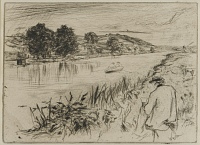Etchings Institutions search term: american art association
Sketching | ||
| Number: | 83 | |
| Date: | 1861 | |
| Medium: | etching and drypoint | |
| Size: | 120 x 166 mm | |
| Signed: | 'Whistler - ' at lower right (1-3); partly removed (4-final) | |
| Inscribed: | no | |
| Set/Publication: | Junior Etching Club, 1862 | |
| No. of States: | 6 | |
| Known impressions: | 35 | |
| Catalogues: | K.86; M.87; T.86; W.69 | |
| Impressions taken from this plate (35) | ||
KEYWORD
TITLE
'A River Scene' (1862, Passages from Modern English Poets). 3
'The Thames' (1870s, possibly Whistler). 4
'The Thames' (1881, Union League Club). 5
'Sketching' (1886, Frederick Wedmore (1844-1921)). 6
'The Thames' (1909, Howard Mansfield (1849-1938)). 7
'Sketching, No. 1' (1910, Edward Guthrie Kennedy (1849-1932). 8
The view undoubtedly shows the Thames, and is a river scene, with a figure sketching in the foreground. Thus Wedmore's title 'Sketching' is appropriate.
Kennedy's numbering was intended to distinguish it from another etching done at the same time, also showing an artist at work, which he called 'Sketching, No. 2' (Sketching, No. 2 [84]).
3: Illustration to C. Mackay's 'A River Scene', Passages from Modern English Poets, London, 1862.
4: Written, possibly by Whistler, on  .
.
5: New York 1881 (cat. no. 97).
6: Wedmore 1886 A (cat. no. 69).
7: Mansfield 1909 (cat. no. 87).
8: Kennedy 1910 (cat. no. 86).
DESCRIPTION
SITTER
 ) and this has been misinterpreted as 'figure probably S.H.' 9 Avery or other scholars may have considered that the figure looked like Whistler himself and therefore was drawn by his brother-in-law. However, it is by no means certain that Haden was present. Whistler's companions are known to have been Edwin Edwards (1823-1879) and Ignace-Henri-Jean-Théodore Fantin-Latour (1836-1904).
) and this has been misinterpreted as 'figure probably S.H.' 9 Avery or other scholars may have considered that the figure looked like Whistler himself and therefore was drawn by his brother-in-law. However, it is by no means certain that Haden was present. Whistler's companions are known to have been Edwin Edwards (1823-1879) and Ignace-Henri-Jean-Théodore Fantin-Latour (1836-1904). 9: Lochnan 1984 , p. 134.
In an earlier etching of the artist at work, Whistler adapted a sketch of his companion Ernest Delannoy (d. 1860/1870) to look more like a self-portrait, and it may be that he followed this practice again.
10: Catalogue of dry points and etchings by Edwin Edwards, cat. nos. 46, 33, 44; Fitzwilliam Museum, P.942-R, P.940-R , P.934-R. Web-page at http://www.fitzmuseum.cam.ac.uk (accessed 2011).
SITE
 ). Although it is not entirely certain that this was written by Whistler, it is correct: the view was probably done near Sunbury-on-Thames, where Whistler was visiting Edwin Edwards (1823-1879).
). Although it is not entirely certain that this was written by Whistler, it is correct: the view was probably done near Sunbury-on-Thames, where Whistler was visiting Edwin Edwards (1823-1879).DISCUSSION
11: Lochnan 1984 , p. 134.

